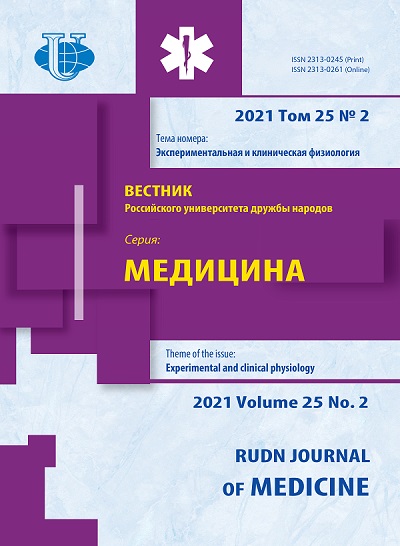Use of modern forensic methods for post-mortem diagnosis of blood loss
- Authors: Sundukov D.V.1, Putintsev V.A.1,2, Shekera V.V.2, Bogomolov D.V.1,2, Romanova O.L.1,3
-
Affiliations:
- Peoples’ Friendship University of Russia (RUDN University)
- Russian Federal Centre of Forensic Medical Expertise
- Federal Clinical and scientific center of Reanimatology and Rehabilitology
- Issue: Vol 25, No 2 (2021): EXPERIMENTAL AND CLINICAL PHYSIOLOGY
- Pages: 154-161
- Section: CLINICAL PHYSIOLOGHY
- URL: https://journals.rudn.ru/medicine/article/view/26561
- DOI: https://doi.org/10.22363/2313-0245-2021-25-2-154-161
Cite item
Full Text
Abstract
In forensic medical practice, when diagnosing the cause of death from blood loss, it is often necessary to solve questions related to the etiology of loss of circulating blood volume (CBV), the degree and severity of the injury, as well as its role in thanatogenesis and the duration of the terminal (agonal) period. When investigating the cases of death from acute blood loss, the authorities often ask forensic experts to solve issues related to the possibility of performing active targeted actions by the dying person, as well as to assess the timeliness of medical care and the actions of medical personnel. The solution of these issues is often difficult for experts, and it is associated with both objective and subjective reasons. For example, in cases where the circumstances of death are unknown, or there are no medical documents, or they do not contain sufficient information, without which it is impossible to conduct a retrospective clinical and anatomical analysis for the purpose of differential diagnosis between hemolytic shock and post-hemorrhagic anemia. The article deals with the use of new methodological approaches in postmortem morphological diagnostics of blood loss by the rate of its development and its role in thanatogenesis, in forensic medical practice. For example, a particular forensic expertise (case study) shows that the application of two new methods allowed to solve the issues for the investigator related to the cause of death and duration of dying from blood loss. Experts’ knowledge of new methodological approaches to the forensic diagnosis of acute blood loss will help law enforcement authorities to counteract crimes against the life of citizens, as well as to development the measures to improve the methods for prevention and reduction of mortality from traumatic injuries with blood loss.
About the authors
D. V. Sundukov
Peoples’ Friendship University of Russia (RUDN University)
Author for correspondence.
Email: olgpharm@yandex.ru
ORCID iD: 0000-0001-8173-8944
Moscow, Russian Federation
V. A. Putintsev
Peoples’ Friendship University of Russia (RUDN University); Russian Federal Centre of Forensic Medical Expertise
Email: olgpharm@yandex.ru
ORCID iD: 0000-0003-0948-0496
Moscow, Russian Federation
V. V. Shekera
Russian Federal Centre of Forensic Medical Expertise
Email: olgpharm@yandex.ru
ORCID iD: 0000-0002-4129-5007
Moscow, Russian Federation
D. V. Bogomolov
Peoples’ Friendship University of Russia (RUDN University); Russian Federal Centre of Forensic Medical Expertise
Email: olgpharm@yandex.ru
ORCID iD: 0000-0002-9061-3569
Moscow, Russian Federation
O. L. Romanova
Peoples’ Friendship University of Russia (RUDN University); Federal Clinical and scientific center of Reanimatology and Rehabilitology
Email: olgpharm@yandex.ru
ORCID iD: 0000-0001-6356-9251
Moscow, Russian Federation
References
- Pigolkin YuI, Putintsev VA, Bogomolov DV, Dolzhansky OV. Determination of the duration of dying from blood loss by morphological signs. Materials of the scientific-practical conference “Actual problems of forensic medicine”. Moscow. 27-28 Mar. 2018. Moscow. 2018: 104-105. (In Russ.)
- Kovalev AV. The procedure for conducting forensic medical examinations and establishing cause-and-effect relationships on the fact of non-provision or improper provision of medical care: methodological recommendations. Moscow. FGBU RCSME. 2017: 32 p. (In Russ.)
- Serov VV, Palstov MA, Ganzen TN. Guide to practical classes in pathological anatomy. Moscow. Meditsina; 1997: 544 p. (In Russ.)
- International Statistical Classification of Diseases and Health-related Problems. Tenth revision (ICD-10). 1-3. Moscow. 1995-1998. (In Russ.)
- A manual of military surgery for the medical services of the armies of the States parties to the Warsaw Pact. Ed. by J.G. Shaposhnikov. Moscow. Military publishing house of Defense Ministry. 1981:122. (In Russ.)
- Bogomolov DV, Bogomolova IN, Dolzhansky OV. Establishing the mechanism of death in the forensic medical examination of a corpse. Forensic-medical expertise. 2005;48(6):9-12. (In Russ.)
- Bogomolov DV, Bogomolova IN, Putintsev VA, et al. Forensic medical diagnostics of the cause of death and the establishment of thanatogenesis by morphological signs: methodological recommendations. M.: FGBU RC SME; 2012. (In Russ.)
- Putintsev VA, Bogomolov DV, Bogomolova IN, Denisova OP. Determination of the duration and rate of dying by morphological characteristics: guidelines. Moscow. FGBU RCSME. 2017:32. (In Russ.)
- Putincev VA, Bogomolov DV, Sundukov DV. Morphological Characteristics of Different Rates of Dying. General Reanimatology. 2018;14(4):35-43. (In Russ) doi: 10.15360/1813-9779-2018-4-35-43
- Putintsev VA. Forensic medical assessment of the dynamics of histomorphological changes in internal organs in critical and terminal conditions. PhD Thesis. Moscow. 2019. 38 p. (In Russ.)
- Dzhuvalyakov PG, Bogomolov DV, Zbrueva YuV, Kabakova SS. Thanatogenetic analysis in pathology and forensic medicine. Astrakhan, 2016;107. (In Russ.)
- Dzhuvalyakov PG, Zbrueva YuV, Dzhuvalyakov DV, et al. Forensic medical assessment of the type and rate of thanatogenesis in some kinds of death: practicum on forensic medicine. Astrakhan. Astrakhan State Medical University. 2017;51. (In Russ.)
- Kovalev AV, Makarov IYu, Kuprina TA, et al. Basic principles of a forensic medical diagnosis formulation. Moscow. 2017:74. (In Russ.)
- Ozhegov SI, Shvedov NYu. Russian Explanatory Dictionary: 80,000 words and phraseological expressions. Moscow. Azbukovnik. 1997: 73. (In Russ.)
- Encyclopedic dictionary of medical terms: in 3 volumes. Edited by B. V. Petrovsky. T.2. M.; Sovetskaya entsiklopediya; 1983: 84-85. (In Russ.)
- Teslenko OV, Shershevsky AL, Edelev IS. Forensic significance of kidney morphology in determining the rate of death. Materials of Congress of forensic physicians with international participation. Moscow, 21-23 Nov. 2018. Moscow. 2019:195-198. (In Russ.)
- Bryusov PG. Determination of the amount of blood loss in emergency surgery. Vestnik khirurgii.1986;6:122-127 (In Russ.).
















